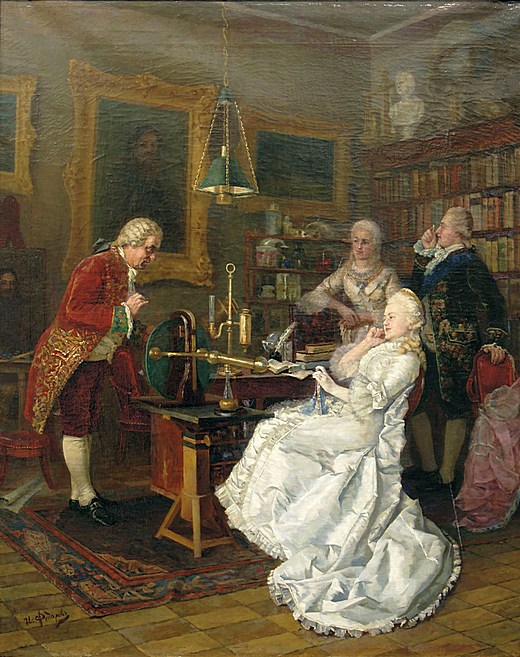Mikhail Lomonosov

Born: Denisovka, Archangelsk Province - 19 November 1711
Died: St. Petersburg - 15 April 1765
Mikhail Lomonosov was the great polymath of the Russian Enlightenment. Born in the deepest provinces of Northern Russia, he managed to gain a first-class education through a combination of natural intelligence and sheer force of will, and went on to make significant advances in several fields of science, as well as writing one of the first Russian grammars, several volumes of history, and a great quantity of poetry. In short, he was instrumental in pulling Russia further into the modern world, and in helping to make St. Petersburg a centre of learning as great as almost any in Europe.
Lomonosov was born in the village of Denisovka (now Lomonosovo), a village about 100 kilometers south-east of Arkhangelsk on the Severnaya Dvina river. His father was a peasant fisherman who had grown rich transporting goods from Arkhangelsk to settlements in the far north. His mother, the daughter of a deacon, died when he was very young, but not before she had taught him to read. From the age of ten, he accompanied his father on voyages to learn the business.

In 1730, however, determined to study, he ran away from home and walked over 1 000 kilometers to Moscow. Claiming to be the son of a provincial priest, he was able to enroll in the Slavic Greek Latin Academy, where he studied for five years before being sent on to St. Petersburg's Academic University. The following year (1736), he was a select group of outstanding students sponsored by the Academy of Sciences to study mathematics, chemistry, physics, philosophy and metallurgy in Western Europe. Lomonosov spent three years at the University of Marburg as a personal student of the philosopher Christian Wolff, then a year studying mining and metallurgy in Saxony, and a further year travelling in Germany and the Low Countries. While in Marburg, he fell in love with and married his landlady's daughter, Elizabeth Christine Zilch.
Due to lack of funds to support his young family, Lomonosov returned to St. Petersburg at the end of 1741, and was immediately appointed adjunct to the physics class at the Academy of Sciences. In 1745 he became the Academy's first Russian-born Professor of Chemistry, and in 1748 the first chemical research laboratory in Russia was built for him.

Throughout his career at the Academy, Lomonosov was a passionate advocate for making education in Russia more accessible to the lower ranks of Russian society. He campaigned to give public lectures in Russian and for the translation into Russian of more scientific texts. In this, he found himself in conflict with one of the founders of the Academy, the German ethnologist Gerhard Friedrich Miller (whose views on the importance of Scandinavians and Germans in Russian history Lomonosov also hotly disputed). By composing and presenting at an official Assembly of the Academy in 1749 his ode to the Empress Elizaveta Petrovna, Lomonosov gained considerable favour at court and a powerful ally in his pedagogical endeavours in the form of Elizaveta's lover, Count Ivan Shuvalov. Together, Lomonosov and Shuvalov founded Moscow University in 1755. It was also thanks to Shuvalov's influence that the Empress granted Lomonosov a manor and four surrounding villages at Ust-Ruditsa, where he was able to implement his plan to open a mosaic and glass factory, the first outside Italy to produce stained glass mosaics.
By 1758, Lomonosov's responsibilities included overseeing the Academy's Geography Department, Historical Assembly, University and Gymnasium, the latter of which he again insisted on making open to lowborn Russians. In 1760, he was appointed a foreign member of the Swedish Royal Academy of Sciences, and in 1764 he was similarly honoured by the Academy of Sciences of the Institute of Bologna. The same year, he was granted by Elizaveta Petrovna the rank of Secretary of State. He died 4 April 1765, and was buried in the Lazarev Cemetery of St. Petersburg's Alexander Nevsky Monastery.

Much of Lomonosov's work was unknown outside Russia until many years after his death, and even now it is more the extraordinary breadth of his inquiry and understanding, rather than any specific grand advancements in a particular field, that make him such a seminal figure in Russian science. Among the highlights of his academic career were his discovery of an atmosphere around Venus, his assertion of the Law of Conservation of Mass (nearly two decades before Antoine Lavoisier), and his development of a prototype of the Herschelian telescope. In 1764, he arranged the expedition along the northern coast of Siberia that discovered the Northeast Passage between the Atlantic and Pacific Oceans. His works also contained intuitions of the wave theory of light and the theory of continental drift. He made improvements to navigational instruments and demonstrated the organic origin of soil, peat, coal, petroleum and amber. Without knowledge of Da Vinci's work, he developed a working prototype of a helicopter.
He wrote the first guide to rhetoric in the Russian language, and his Russian Grammar was among the first to codify the language. His Ancient Russian History compared the development of Russia to the development of the Roman Empire, a theme that would become increasingly popular in the 19th century. His poetry was much praised during his lifetime, although it has been largely ignored by posterity.

Lomonosov is remembered in central St. Petersburg in the names of Ulitsa Lomonosova ("Lomonosov Street"), Ploshchad Lomonosova ("Lomonosov Square") and the adjacent bridge across the Fontanka River. During the Soviet Period, his name was given to the Imperial Porcelain Manufactory, and hence to the nearby metro station, Lomonosovskaya. The Soviets also renamed the suburban town of Oranienburg as Lomonosovo. In 1986, a magnificent monument to Lomonosov was unveiled in front of the Twelve Colleges, the main campus of St. Petersburg State University, acknowledging the enormous debt that institution owes the great polymath who is rightfully considered the father of Russian science.

